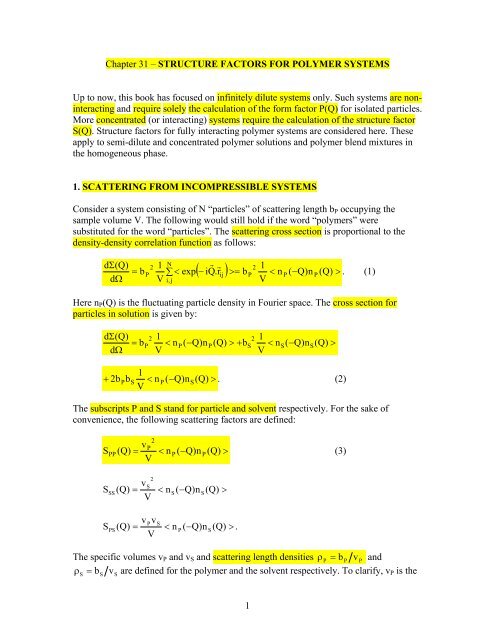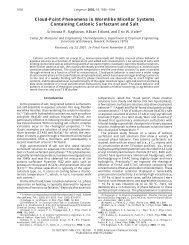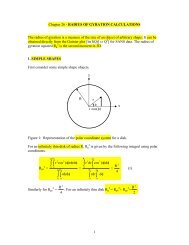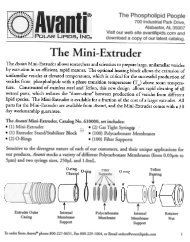structure factors for polymer systems - NIST Center for Neutron ...
structure factors for polymer systems - NIST Center for Neutron ...
structure factors for polymer systems - NIST Center for Neutron ...
Create successful ePaper yourself
Turn your PDF publications into a flip-book with our unique Google optimized e-Paper software.
Chapter 31 – STRUCTURE FACTORS FOR POLYMER SYSTEMS<br />
Up to now, this book has focused on infinitely dilute <strong>systems</strong> only. Such <strong>systems</strong> are noninteracting<br />
and require solely the calculation of the <strong>for</strong>m factor P(Q) <strong>for</strong> isolated particles.<br />
More concentrated (or interacting) <strong>systems</strong> require the calculation of the <strong>structure</strong> factor<br />
S(Q). Structure <strong>factors</strong> <strong>for</strong> fully interacting <strong>polymer</strong> <strong>systems</strong> are considered here. These<br />
apply to semi-dilute and concentrated <strong>polymer</strong> solutions and <strong>polymer</strong> blend mixtures in<br />
the homogeneous phase.<br />
1. SCATTERING FROM INCOMPRESSIBLE SYSTEMS<br />
Consider a system consisting of N “particles” of scattering length bP occupying the<br />
sample volume V. The following would still hold if the word “<strong>polymer</strong>s” were<br />
substituted <strong>for</strong> the word “particles”. The scattering cross section is proportional to the<br />
density-density correlation function as follows:<br />
dΣ(<br />
Q)<br />
= b<br />
dΩ<br />
2<br />
P<br />
1<br />
V<br />
N<br />
∑ < exp −<br />
i,<br />
j<br />
r r 2 1<br />
( iQ.<br />
r ) >= b < n ( −Q)<br />
n ( Q)<br />
><br />
ij<br />
P<br />
1<br />
V<br />
P<br />
P<br />
. (1)<br />
Here nP(Q) is the fluctuating particle density in Fourier space. The cross section <strong>for</strong><br />
particles in solution is given by:<br />
dΣ(<br />
Q)<br />
= b<br />
dΩ<br />
2<br />
P<br />
1<br />
V<br />
< n<br />
P<br />
( −Q)<br />
n<br />
P<br />
( Q)<br />
> + b<br />
2<br />
S<br />
1<br />
V<br />
< n ( −Q)<br />
n ( Q)<br />
><br />
1<br />
+ 2bP bS<br />
< n P ( −Q)<br />
nS<br />
( Q)<br />
> . (2)<br />
V<br />
The subscripts P and S stand <strong>for</strong> particle and solvent respectively. For the sake of<br />
convenience, the following scattering <strong>factors</strong> are defined:<br />
2<br />
SPP P<br />
(3)<br />
vP<br />
( Q)<br />
= < n P ( −Q)<br />
n ( Q)<br />
><br />
V<br />
2<br />
vS<br />
( Q)<br />
= < n S ( −Q)<br />
n ( Q)<br />
><br />
V<br />
SSS S<br />
v Pv<br />
S<br />
( Q)<br />
= < n P ( −Q)<br />
n ( Q)<br />
> .<br />
V<br />
SPS S<br />
The specific volumes vP and vS and scattering length densities ρ P = b P v P and<br />
ρ = b v are defined <strong>for</strong> the <strong>polymer</strong> and the solvent respectively. To clarify, vP is the<br />
S<br />
S<br />
S<br />
S<br />
S
monomer volume and vS is the volume of the solvent molecule. The scattering cross<br />
section becomes:<br />
dΣ(<br />
Q)<br />
= ρ<br />
dΩ<br />
2<br />
P<br />
S<br />
PP<br />
( Q)<br />
+ ρ<br />
2<br />
S<br />
S<br />
SS<br />
( Q)<br />
+ 2ρ<br />
ρ<br />
P<br />
2<br />
S<br />
S<br />
PS<br />
( Q)<br />
. (4)<br />
Most scattering <strong>systems</strong> are incompressible. It is often convenient to make the following<br />
incompressibility assumption:<br />
v P n P ( Q)<br />
+ vSn<br />
S ( Q)<br />
= 0.<br />
(5)<br />
This introduces the following simplification:<br />
2<br />
2<br />
v S<br />
In other words:<br />
P < n P ( −Q)<br />
n P ( Q)<br />
> = vS<br />
< n S ( −Q)<br />
n ( Q)<br />
><br />
(6)<br />
= − v < n ( −Q)<br />
n ( Q)<br />
> .<br />
v P S P S<br />
SPP SS<br />
PS<br />
SP<br />
( Q)<br />
= S ( Q)<br />
= −S<br />
( Q)<br />
= −S<br />
( Q)<br />
(7)<br />
This simplifies the cross section to the following <strong>for</strong>m:<br />
dΣ(<br />
Q)<br />
= ( ρ<br />
dΩ<br />
P<br />
− ρ<br />
S<br />
)<br />
2<br />
S<br />
PP<br />
(<br />
Q)<br />
= Δρ<br />
2<br />
S<br />
PP<br />
( Q)<br />
. (8)<br />
This is reasonable since the contrast factor Δρ 2 is always calculated relative to a<br />
“background” scattering length density value. Here, the solvent’s scattering length<br />
density is taken to be that reference value.<br />
2. INTER-PARTICLE INTERACTIONS<br />
Consider a system consisting of N <strong>polymer</strong>s of contrast factor Δρ 2 occupying volume V.<br />
Each <strong>polymer</strong> comprises n monomers of volume v each so that the <strong>polymer</strong> volume is vP<br />
= nv. Let us separate out the intra-<strong>polymer</strong> and the inter-<strong>polymer</strong> terms in the scattering<br />
cross section as follows:<br />
2<br />
r r<br />
N n r ⎤<br />
( − iQ.<br />
rαiβj<br />
) > + < exp(<br />
− iQ.<br />
rαiβj<br />
) ⎥⎦<br />
dΣ( Q)<br />
⎡ N n<br />
2 v<br />
r<br />
= Δρ<br />
⎢ ∑∑< exp<br />
∑∑ ><br />
dΩ<br />
V ⎣α=<br />
β i,<br />
j<br />
α≠β<br />
i,<br />
j<br />
. (9)<br />
The indices α and β run over the <strong>polymer</strong> chains and the indices i and j run over the<br />
monomers in a specific <strong>polymer</strong> chain. Consider a pair of <strong>polymer</strong> coils (called 1 and 2)<br />
and sum over all pairs.
2<br />
r r<br />
n r ⎤<br />
( − iQ.<br />
r1i<br />
1j<br />
) + N(<br />
N −1)<br />
∑ < exp(<br />
− iQ.<br />
r1i<br />
2 j ) > ⎥⎦<br />
dΣ( Q)<br />
⎡ n<br />
2 v<br />
r<br />
= Δρ<br />
⎢N∑<br />
< exp ><br />
dΩ<br />
V ⎣ i,<br />
j<br />
i,<br />
j<br />
3<br />
. (10)<br />
Note that this <strong>for</strong>malism holds if the word “particles” were to be substituted <strong>for</strong> the word<br />
“<strong>polymer</strong>s” assuming (of course) that the particles have internal <strong>structure</strong> (think<br />
monomers).<br />
Figure 1: Schematic representation of the coordinate system showing a pair of scatterers<br />
that belong to two different <strong>polymer</strong> coils.<br />
r<br />
The inter-distance between the scattering pair r1i<br />
2 j can be expressed as<br />
r r r r<br />
r = −S<br />
+ S + R and the inter-particle average can be split into the following parts:<br />
1i2<br />
j<br />
1i<br />
exp<br />
2 j<br />
12<br />
r r<br />
r r<br />
r r<br />
r r<br />
( − iQ.<br />
r ) > = < exp(<br />
iQ.<br />
S ) >< exp(<br />
− iQ.<br />
S ) >< exp(<br />
− iQ.<br />
R ) ><br />
< 1i2<br />
j<br />
1i<br />
2 j<br />
12<br />
. (11)<br />
The first two averages are within single particles and the third average is across particles.<br />
The summations become:<br />
n<br />
r r<br />
r r n r r n r r<br />
( − iQ.<br />
S ) =< exp(<br />
− iQ.<br />
R ) > ∑ < exp(<br />
iQ.<br />
S ) > < exp(<br />
− iQ.<br />
S )<br />
∑ < exp ><br />
i,<br />
j<br />
1i2<br />
j<br />
The <strong>for</strong>m factor amplitude is defined as:<br />
F(<br />
Q)<br />
=<br />
R r<br />
coil 1<br />
S1i r<br />
r r 1 n r r<br />
( − iQ.<br />
S ) = < exp(<br />
− iQ.<br />
S )<br />
1 n<br />
∑ < exp 1i<br />
><br />
n i<br />
1<br />
r<br />
1i<br />
R r<br />
r<br />
2 j<br />
12<br />
R r<br />
12<br />
2<br />
i<br />
r<br />
1i2<br />
j<br />
1i<br />
∑ > .(12)<br />
∑ 2 j > . (13)<br />
n j<br />
j<br />
S2 j<br />
coil 2<br />
r<br />
2 j
The single-particle <strong>for</strong>m factor itself is defined as:<br />
P(<br />
Q)<br />
r r<br />
( − iQ.<br />
S )<br />
1 n<br />
= ∑ < exp 1i1j<br />
> . (14)<br />
2<br />
n i,<br />
j<br />
2<br />
For uni<strong>for</strong>m density particles, the following relation holds P ( Q)<br />
= | F(<br />
Q)<br />
| . This is not<br />
true, however, <strong>for</strong> non-uni<strong>for</strong>m density object such as <strong>polymer</strong> coils.<br />
An inter-particle <strong>structure</strong> factor is defined as:<br />
S<br />
I<br />
( Q)<br />
=<br />
1<br />
N<br />
N<br />
r r<br />
( − iQ.<br />
R )<br />
∑ < exp > . (15)<br />
α,<br />
β<br />
The cross section can there<strong>for</strong>e be written as follows:<br />
dΣ(<br />
Q)<br />
dΩ<br />
= Δρ<br />
2<br />
2 2<br />
v n N<br />
V<br />
αβ<br />
2<br />
[ P(<br />
Q)<br />
+ | F(<br />
Q)<br />
| ( S ( Q)<br />
−1)<br />
]<br />
4<br />
I<br />
. (16)<br />
r r<br />
Note that the statistical average < exp(<br />
iQ.<br />
r1i<br />
2 j ) > involves integration over the following<br />
r r r<br />
probability distribution P( r1i<br />
, r2<br />
j,<br />
R12<br />
) which can be split to show a conditional probability<br />
r r r r r r r<br />
P( r1i<br />
, r2<br />
j,<br />
R12<br />
) = P(<br />
r1i<br />
, r2<br />
j | R12<br />
) P(<br />
R12<br />
) . For compact scatterers which do not interfere with<br />
r r r<br />
each other’s rotation P( r1i<br />
, r2<br />
j | R12<br />
) is independent of R12 r r<br />
. P( R12<br />
) is the probability of<br />
finding the centers of mass of <strong>polymer</strong> coils 1 and 2 a distance R12 r<br />
apart.<br />
S<br />
I<br />
( Q)<br />
r r N r r r r<br />
( − iQ.<br />
R ) >= dR<br />
P(<br />
R ) exp(<br />
− iQ.<br />
R )<br />
= N < exp 12 ∫ 12 12<br />
12 . (17)<br />
V<br />
The cross section <strong>for</strong> <strong>systems</strong> in this case is given by:<br />
dΣ(<br />
Q)<br />
dΩ<br />
= Δρ<br />
2<br />
2 2<br />
2<br />
v n N ⎡ | F(<br />
Q)<br />
|<br />
P(<br />
Q)<br />
⎢1<br />
+<br />
V ⎣ P(<br />
Q)<br />
( SI<br />
( Q)<br />
−1)<br />
⎥⎦<br />
⎤<br />
. (18)<br />
This result applies to <strong>systems</strong> with non-spherical symmetry and non-uni<strong>for</strong>m density such<br />
as <strong>polymer</strong>s. Polymer are, however, so highly entangled that an inter-chain <strong>structure</strong><br />
factor SI(Q) is meaningless except <strong>for</strong> dilute solutions whereby <strong>polymer</strong> coils do not<br />
overlap. Inter-chain interactions <strong>for</strong> <strong>polymer</strong> <strong>systems</strong> are better handled using other<br />
methods described below.<br />
Uni<strong>for</strong>m density scatterers (such as particles) are characterized by<br />
that:<br />
2<br />
P ( Q)<br />
= | F(<br />
Q)<br />
| , so
dΣ(<br />
Q)<br />
dΩ<br />
2<br />
= Δρ<br />
2 2<br />
v n N<br />
P(<br />
Q)<br />
SI<br />
( Q)<br />
. (19)<br />
V<br />
Defining a particles’ volume fraction as φ = Nnv/V, the following result is obtained:<br />
d 2<br />
Σ(<br />
Q)<br />
= Δρ<br />
S(<br />
Q)<br />
dΩ<br />
( Q)<br />
= nφvP(<br />
Q)<br />
S ( Q)<br />
.<br />
S I<br />
This is a well-known result. It is included here even-though it does not apply to <strong>polymer</strong><br />
<strong>systems</strong> so that the derivation does not have to be repeated when covering scattering from<br />
particulate <strong>systems</strong> later. Note that the scattering factor S(Q) and the inter-particle<br />
<strong>structure</strong> factor SI(Q) should not be confused; S(Q) has the dimension of a volume<br />
whereas SI(Q) is dimensionless.<br />
3. THE PAIR CORRELATION FUNCTION<br />
Recall the definition <strong>for</strong> the inter-particle <strong>structure</strong> factor <strong>for</strong> a pair of particles (named 1<br />
and 2):<br />
S<br />
I<br />
( Q)<br />
= N < exp<br />
=<br />
1<br />
NV<br />
N<br />
α,<br />
β<br />
r r 1 N r r<br />
( − iQ.<br />
R ) >= < exp(<br />
− iQ.<br />
R )<br />
3<br />
∑ ∫ d R<br />
αβ<br />
∑<br />
N α,<br />
β<br />
εβ ><br />
r r<br />
exp − iQ.<br />
R<br />
r<br />
P(<br />
R ) .<br />
12<br />
( )<br />
r<br />
P( R αβ ) is the probability of finding particle β in volume d 3 Rαβ a distance R αβ<br />
r<br />
away<br />
given that particle α at the origin. When the self term (α = β) is omitted, this result<br />
becomes:<br />
αβ<br />
r r<br />
( iQ.<br />
R )<br />
1 N r<br />
r<br />
3<br />
SI<br />
( Q)<br />
−1<br />
= ∑ ∫ d R εβ exp − αβ P(<br />
R αβ ) (22)<br />
NV α≠β<br />
N r r r r<br />
3<br />
= ∫ d R12<br />
exp(<br />
− iQ.<br />
R12<br />
) P(<br />
R12<br />
) .<br />
V<br />
r<br />
The probability P( R12<br />
) is referred to as the pair correlation function and is often called<br />
r<br />
( R ) . Removing the <strong>for</strong>ward scattering term yields the following well known result:<br />
g 12<br />
S<br />
I<br />
( Q)<br />
−1<br />
=<br />
N<br />
∫ d<br />
V<br />
3<br />
R<br />
12<br />
exp<br />
5<br />
αβ<br />
r r r<br />
3<br />
( − iQ.<br />
R )[ g(<br />
R ) −1]<br />
+ ( 2π)<br />
δ(<br />
Q)<br />
12<br />
12<br />
(20)<br />
(21)<br />
. (23)
The last term (containing the Dirac Delta function) is irrelevant and can be neglected.<br />
r<br />
This last equation shows that SI ( Q)<br />
− 1 and g( R12<br />
) −1<br />
are a Fourier trans<strong>for</strong>m pair. Note<br />
r<br />
that g( R12<br />
) peaks at the first nearest-neighbor shell and goes asymptotically to unity at<br />
r r<br />
large distances. The total correlation function is introduced as ( R ) = g(<br />
R ) −1.<br />
4. POLYMER SOLUTIONS<br />
6<br />
h 12<br />
12<br />
In the case of <strong>polymer</strong> solutions, the Zimm single-contact approximation (Zimm, 1946;<br />
Zimm, 1948) is a simple way of expressing the inter-<strong>polymer</strong> <strong>structure</strong> factor. Within that<br />
approximation, the first order term in a “concentration” expansion is as follows:<br />
n<br />
r<br />
2<br />
r vex<br />
⎛ v 2 ⎞<br />
( − iQ.<br />
r ) = − ⎜ n P(<br />
Q)<br />
⎟ + ...<br />
∑ < exp ><br />
i,<br />
j<br />
1 i2<br />
j<br />
V ⎜<br />
⎝ V<br />
vex is a dimensionless factor representing interactions. The cross section becomes an<br />
expansion:<br />
Σ(<br />
Q)<br />
2 ⎡ v ex<br />
= Δρ<br />
⎢S0<br />
( Q)<br />
−<br />
dΩ<br />
⎣ V<br />
d 2<br />
⎟<br />
⎠<br />
( S0<br />
( Q)<br />
) + ... ⎥<br />
⎦<br />
2<br />
(24)<br />
⎤<br />
. (25)<br />
2<br />
This expansion can be resumed as follows 1 x + x ... = 1 ( 1+<br />
x)<br />
dΣ(<br />
Q)<br />
dΩ<br />
= Δρ<br />
2<br />
− to yield:<br />
S0<br />
( Q)<br />
. (26)<br />
v ex<br />
1+<br />
S0<br />
( Q)<br />
V<br />
The bare <strong>structure</strong> factor <strong>for</strong> non-interacting <strong>polymer</strong>s has been defined as:<br />
S<br />
0<br />
( Q)<br />
2 2<br />
Nn v<br />
= P(<br />
Q)<br />
= nφvP(<br />
Q)<br />
. (27)<br />
V<br />
Resuming the series extends the single-contact approximation’s applicability range to a<br />
wide concentration regime. The single-contact approximation applies best to semi-dilute<br />
solutions.
Figure 2: Typical interactions that are included and those that are excluded within the<br />
single-contact approximation.<br />
5. THE ZERO CONTRAST METHOD<br />
The zero contrast (or scattering length density match) method also called the high<br />
concentration method <strong>for</strong> <strong>polymer</strong> <strong>systems</strong> consists of using a mixture of deuterated and<br />
non-deuterated <strong>polymer</strong>s and deuterated and non-deuterated solvents in order to isolate<br />
the single-chain <strong>for</strong>m factor; i.e., in order to cancel out the inter-chain interaction terms.<br />
The scattering cross section <strong>for</strong> a <strong>polymer</strong> solution containing both deuterated and nondeuterated<br />
<strong>polymer</strong>s is given by:<br />
dΣ(<br />
Q)<br />
dΩ<br />
= Δρ<br />
2<br />
D<br />
S<br />
DD<br />
Included Interactions<br />
( Q)<br />
Excluded Interactions<br />
+<br />
Δρ<br />
2<br />
H<br />
S<br />
HH<br />
( Q)<br />
7<br />
+ 2Δρ<br />
D<br />
Δρ<br />
H<br />
S<br />
HD<br />
( Q)<br />
. (28)<br />
The scattering length density differences between the deuterated (or hydrogenated)<br />
<strong>polymer</strong> and the solvent are:
Δρ<br />
Δρ<br />
D<br />
H<br />
=<br />
=<br />
⎛ b<br />
⎜<br />
⎝ v<br />
⎛ b<br />
=<br />
⎜<br />
⎝ v<br />
( ) ⎟ D S<br />
ρ − ρ = ⎜ −<br />
D<br />
S<br />
D<br />
b<br />
v<br />
S<br />
⎞<br />
⎠<br />
⎞<br />
.<br />
⎠<br />
( ) ⎟ H S<br />
ρ − ρ −<br />
H<br />
S<br />
H<br />
b<br />
v<br />
S<br />
The various partial scattering <strong>factors</strong> are split into single-chain parts and inter-chain parts<br />
as follows:<br />
S<br />
I<br />
[ P D ( Q)<br />
+ φ P ( Q)<br />
]<br />
8<br />
(29)<br />
S ( Q)<br />
= n φ v<br />
DD<br />
(30)<br />
DD<br />
D<br />
D<br />
D<br />
S<br />
I<br />
[ P H ( Q)<br />
+ φ P ( Q)<br />
]<br />
S ( Q)<br />
= n φ v<br />
HH<br />
HH<br />
H<br />
H<br />
H<br />
SHD H H H D D D H D HD<br />
I<br />
( Q)<br />
= n φ v n φ v φ φ P ( Q)<br />
.<br />
D<br />
H<br />
Note that the inter-chain <strong>structure</strong> <strong>factors</strong> could be negative depending on the volume<br />
fraction. Assume that deuterated and hydrogenated <strong>polymer</strong>s have the same degree of<br />
<strong>polymer</strong>ization ( n D = n H = n P ), and the same specific volume ( v D = v H = v P ), and<br />
define the <strong>polymer</strong> volume fraction as φ P = φD<br />
+ φH<br />
. The contrast match method consists<br />
in varying the relative deuterated to hydrogenated volume fraction but keeping the total<br />
<strong>polymer</strong> volume fraction constant.<br />
Define the following “average of the square” and “square of the average” <strong>polymer</strong><br />
contrast <strong>factors</strong>:<br />
2 ⎡ 2 φD<br />
2 φH<br />
⎤<br />
{ Δ P } = ⎢Δρ<br />
D + ΔρH<br />
⎥<br />
⎣ φP<br />
φP<br />
⎦<br />
B (31)<br />
2<br />
2 ⎡ φD<br />
φH<br />
⎤<br />
BP = ⎢Δρ<br />
D + ΔρH<br />
⎥<br />
⎣ φP<br />
φP<br />
⎦<br />
{ }<br />
Δ .<br />
The scattering cross section becomes:<br />
dΣ(<br />
Q)<br />
=<br />
dΩ<br />
2<br />
2<br />
{ ΔB<br />
} n φ v P ( Q)<br />
+ { ΔB<br />
} n φ v P ( Q)<br />
P<br />
P<br />
P<br />
P<br />
S<br />
P<br />
2<br />
2<br />
2<br />
( { Δ } − { ΔB<br />
} ) n φ v P ( Q)<br />
+ { ΔB<br />
} n φ v P ( Q)<br />
= . (32)<br />
BP P P P P S<br />
P P P P T<br />
The following definition has been used:<br />
PT S<br />
P I<br />
( Q)<br />
= P ( Q)<br />
+ φ P ( Q)<br />
. (33)<br />
Note the following simplifications:<br />
P<br />
P<br />
P<br />
I
2<br />
2<br />
2 φDφ<br />
{ BP<br />
} − { ΔBP<br />
} = ( ρD<br />
− ρH<br />
) 2<br />
H<br />
Δ . (34)<br />
φP<br />
φ φ φ φ<br />
Δ .<br />
φ φ φ φ<br />
D<br />
H<br />
D<br />
H<br />
{ BP } = ΔρD<br />
+ ΔρH<br />
= ρD<br />
+ ρH<br />
− ρS<br />
The final result follows:<br />
dΣ(<br />
Q)<br />
=<br />
dΩ<br />
P<br />
P<br />
P<br />
2 D H<br />
D<br />
H<br />
( ρ − ρ ) n φ v P ( Q)<br />
+ ⎜ρ<br />
+ ρ − ρ ⎟ n φ v P ( Q)<br />
D<br />
H<br />
φ<br />
φ<br />
φ<br />
2<br />
P<br />
P<br />
P<br />
P<br />
S<br />
⎛<br />
⎜<br />
⎝<br />
9<br />
D<br />
φ<br />
φ<br />
P<br />
P<br />
H<br />
φ<br />
φ<br />
P<br />
S<br />
⎞<br />
⎟<br />
⎠<br />
2<br />
P<br />
P<br />
P<br />
T<br />
. (35)<br />
Setting the second contrast factor (between the <strong>polymer</strong> and the solvent) to zero cancels<br />
the second term containing PT(Q) leaving only the first term containing the single-chain<br />
<strong>for</strong>m factor PS(Q). This zero contrast condition is there<strong>for</strong>e:<br />
φ<br />
φ<br />
D<br />
H<br />
ρ D + ρH<br />
= ρS<br />
. (36)<br />
φP<br />
φP<br />
Note that in general in order to achieve this condition, the solvent must also consist of<br />
mixtures of deuterated and non-deuterated solvents. Defining the following four indices<br />
DP, HP, DS, and HS <strong>for</strong> deuterated <strong>polymer</strong>, non-deuterated (hydrogenated) <strong>polymer</strong>,<br />
deuterated solvent and non-deuterated solvent, the contrast match condition becomes in<br />
the general case:<br />
φ<br />
φ<br />
φ<br />
DP<br />
HP<br />
DS<br />
HS<br />
ρ DP + ρHP<br />
= ρDS<br />
+ ρHS<br />
. (37)<br />
φP<br />
φP<br />
φS<br />
φS<br />
Note that φDP + φHP = φP , φDS + φHS = φP and φP + φS = 1.<br />
6. THE RANDOM PHASE APPROXIMATION<br />
φ<br />
The random phase approximation (de Gennes, 1979, Akcasu-Tombakoglu, 1990;<br />
Hammouda, 1993; Higgins-Benoit, 1994) is a simple mean-field approach used to<br />
calculate the linear response of a homogeneous <strong>polymer</strong> mixture following a<br />
thermodynamic fluctuation. Consider a binary mixture consisting of a mixture of<br />
<strong>polymer</strong>s 1 and 2 with fluctuating densities n1(Q) and n2(Q). The interaction potentials<br />
between monomers 1 and 2 are W11, W12, W21 and W22. Assume an external perturbation<br />
represented by potentials U1 and U2 and a constraint u that helps apply the<br />
incompressibility assumption. The parameter u can be thought of as a Lagrange<br />
multiplier in an optimization problem with constraints. The constraint here is the<br />
incompressibility condition. The linear response equations follow:
0 ⎡ U1<br />
+ u + W11v1n<br />
1(<br />
Q)<br />
+ W12v<br />
2n<br />
2 ( Q)<br />
⎤<br />
v1<br />
n1<br />
( Q)<br />
= −S11(<br />
Q)<br />
⎢<br />
⎥ (38a)<br />
⎣<br />
k BT<br />
⎦<br />
v<br />
2<br />
n<br />
2<br />
( Q)<br />
= −S<br />
0<br />
22<br />
v1 1<br />
2 2<br />
⎡ U 2 + u + W21v1n<br />
1(<br />
Q)<br />
+ W<br />
( Q)<br />
⎢<br />
⎣<br />
k BT<br />
10<br />
22<br />
v<br />
2<br />
n<br />
2<br />
( Q)<br />
⎤<br />
⎥ (38b)<br />
⎦<br />
n ( Q)<br />
+ v n ( Q)<br />
= 0 . (38c)<br />
The last equation represents the incompressibility constraint. The non-interacting or<br />
“bare” <strong>structure</strong> <strong>factors</strong> S ( Q)<br />
0<br />
11 and S ( Q)<br />
0<br />
22 have been defined. These equations have<br />
assumed that no co<strong>polymer</strong>s are present in the homogeneous mixture; i.e., that<br />
0<br />
0<br />
S ( Q)<br />
= S ( Q)<br />
= 0 .<br />
12<br />
21<br />
In order to solve the set of linear equations, we extract the perturbing potential u from the<br />
second equation and substitute it into the first equation to obtain:<br />
0 ⎡U<br />
1 − U 2<br />
⎤<br />
1 n1<br />
( Q)<br />
= −S11(<br />
Q)<br />
⎢ + v11(<br />
Q)<br />
n ( Q)<br />
⎥ . (39)<br />
⎣ k BT<br />
⎦<br />
v 1<br />
This applies along with the following equation representing the response of the fully<br />
interacting system:<br />
⎡U 1 − U 2 ⎤<br />
v1<br />
n1<br />
( Q)<br />
= −S11(<br />
Q)<br />
⎢ ⎥ . (40)<br />
⎣ k BT<br />
⎦<br />
The factor v11(Q) and the Flory-Huggins interaction parameter χ12 are defined as:<br />
v<br />
χ<br />
11<br />
12<br />
( Q)<br />
1<br />
2χ<br />
12<br />
= −<br />
(41)<br />
0<br />
S22<br />
( Q)<br />
v 0<br />
W12<br />
⎛ W11<br />
+ W<br />
= − ⎜<br />
k BT<br />
⎝ 2k<br />
BT<br />
22<br />
Here v0 is a reference volume (often taken to be v 0 = v1v<br />
2 ).<br />
⎟ ⎞<br />
.<br />
⎠<br />
The RPA result <strong>for</strong> a homogeneous binary blend mixture follows:<br />
1 1 1 2χ<br />
S ( Q)<br />
11<br />
12<br />
= + −<br />
(42)<br />
0<br />
0<br />
S11(Q)<br />
S22<br />
(Q) v 0
0<br />
S11 1 1 1 1<br />
( Q)<br />
= n φ v P ( Q)<br />
.<br />
4<br />
g1<br />
2 2<br />
2 2<br />
[ exp( −Q<br />
R ) −1<br />
Q R ]<br />
2<br />
P 1(<br />
Q)<br />
=<br />
4<br />
g1<br />
+<br />
Q R<br />
Rg1 is the radius of gyration. The incompressibility assumption yields the simplifying<br />
relations:<br />
S11 22<br />
12<br />
( Q)<br />
= S ( Q)<br />
= −S<br />
( Q)<br />
= S(<br />
Q)<br />
. (43)<br />
The scattering cross section is given by:<br />
Σ(<br />
Q)<br />
= ( ρ<br />
dΩ<br />
d 2<br />
1 − ρ2<br />
)<br />
( ρ − ρ )<br />
1<br />
2<br />
dΣ(<br />
Q)<br />
dΩ<br />
2<br />
0<br />
11<br />
S(<br />
Q)<br />
1 1 2χ<br />
= + −<br />
S (Q) S (Q) v<br />
0<br />
22<br />
12<br />
0<br />
This is the so-called de Gennes <strong>for</strong>mula representing the scattering cross section <strong>for</strong><br />
<strong>polymer</strong> blends in the single-phase (mixed phase) region. This is based on the Random<br />
Phase Approximation that applies <strong>for</strong> long degree of <strong>polymer</strong>izations (n1>>1 and n2>>2)<br />
and far from the phase boundary condition. This approach does not apply inside the<br />
demixed phase region.<br />
This <strong>for</strong>malism also applies to <strong>polymer</strong> solutions by replacing one of the <strong>polymer</strong>s (say<br />
component 2) by solvent; i.e., by setting n2 = 1 and P2(Q) = 1. In the case of <strong>polymer</strong><br />
solutions, the excluded volume effect is included in the <strong>polymer</strong> <strong>for</strong>m factor P1(Q). Note<br />
that the second virial coefficient can be defined <strong>for</strong> <strong>polymer</strong> solutions as<br />
= v ( Q = 0)<br />
2 .<br />
A 2 11<br />
The phase separation condition is achieved when the scattering intensity “blows up”; i.e.,<br />
in the limit ( Q = 0)<br />
→ ∞ . This is achieved <strong>for</strong><br />
S<br />
0<br />
11<br />
S 11<br />
( 0)<br />
.<br />
11<br />
g1<br />
(44)<br />
0 2χ12<br />
0 0<br />
+ S22<br />
( 0)<br />
− S11(<br />
0)<br />
S22<br />
( 0)<br />
= 0 . (45)<br />
v<br />
0<br />
This is the so-called spinodal condition. Note that with the simplifying assumptions that<br />
n1 = n2 = n, v1 = v2 = v0 and φ1 = φ2 = 0.5, the spinodal condition <strong>for</strong> <strong>polymer</strong> blends<br />
simplifies to n 2 = χ .<br />
12
7. THE ISOTHERMAL COMPRESSIBILITY FACTOR<br />
Most mixed <strong>polymer</strong> <strong>systems</strong> have finite compressibility. The scattering cross section<br />
consists of a Q-dependent coherent scattering term which is a good monitor of the<br />
<strong>structure</strong>, a Q-independent incoherent scattering term (mostly from hydrogen scattering),<br />
and another Q-independent “isothermal compressibility” term expressed as:<br />
⎡ dΣ<br />
⎤<br />
⎢<br />
⎣dΩ<br />
⎥<br />
⎦<br />
iso−comp<br />
= Δρ<br />
2<br />
k<br />
B<br />
T χ<br />
T<br />
. (46)<br />
Here Δρ 2 is the contrast factor, kBT is the temperature in energy units and χT is the<br />
isothermal compressibility which is defined as:<br />
1 ⎛ ∂V<br />
⎞<br />
χ T = − ⎜ ⎟ . (47)<br />
V ⎝ ∂P<br />
⎠<br />
T<br />
The isothermal compressibility term is usually small compared to the other terms. For<br />
example, χT = 4.57*10 -4 cm 3 /J <strong>for</strong> pure water at 25 o C and atmospheric pressure (Weast,<br />
1984). χT is set equal to zero altogether <strong>for</strong> incompressible mixtures.<br />
REFERENCES<br />
B. Zimm, “Application of the Methods of Molecular Distribution to Solutions of Large<br />
Molecules”, J. Chem. Phys. 14, 164 (1946); and B. Zimm, “The Scattering of Light and<br />
the Radial Distribution Function of High Polymer Solutions”, J. Chem. Phys. 16, 1093<br />
(1948).<br />
P.G. de Gennes, "Scaling Concepts in Polymer Physics", Cornell University Press, New<br />
York (1979).<br />
A.Z. Akcasu and M. Tombakoglu, “Dynamics of Co<strong>polymer</strong> and Homo<strong>polymer</strong> Mixtures<br />
in Bulk and in Solution via the Random Phase Approximation”, Macromolecules 23,<br />
607-612 (1990)<br />
B. Hammouda, "SANS from Homogeneous <strong>polymer</strong> Mixtures: A Unified Overview",<br />
Advances in Polymer Science 106, 87 (1993).<br />
J.S. Higgins and H. Benoit, "Polymers and <strong>Neutron</strong> Scattering", Ox<strong>for</strong>d (1994).<br />
R.C. Weast, Editor-in-Chief, “CRC Handbook of Chemistry and Physics”, CRC Press<br />
(1984)<br />
12
QUESTIONS<br />
1. What is the primary effect of the incompressibility assumption on the scattering cross<br />
section?<br />
2. If an incompressible <strong>polymer</strong> solution is characterized by one (independent) <strong>structure</strong><br />
factor, how many <strong>structure</strong> <strong>factors</strong> describe the equivalent compressible solution?<br />
3. What is the Zimm single-contact approximation?<br />
4. Does the inter-chain <strong>structure</strong> factor (with excluded volume) <strong>for</strong> dilute <strong>polymer</strong><br />
solutions tend to increase or decrease the scattering intensity at low-Q?<br />
5. What is the use of the zero contrast condition in concentrated <strong>polymer</strong> <strong>systems</strong>? What<br />
is the procedure to follow?<br />
6. The Random Phase Approximation applies in what conditions?<br />
7. What is the origin of monomer/monomer interactions in <strong>polymer</strong> mixtures?<br />
8. Are <strong>polymer</strong> chains in mixed <strong>polymer</strong> blends characterized by excluded volume; i.e.,<br />
are they swollen?<br />
9. What is the pair correlation function g(r)?<br />
10. Estimate kBTχT (χT is the isothermal compressibility) <strong>for</strong> pure water <strong>for</strong> 25 o C and 1<br />
atmosphere pressure.<br />
ANSWERS<br />
1. The primary effect of the incompressibility assumption is to simplify the scattering<br />
dΣ(<br />
Q)<br />
2<br />
2<br />
cross section from its full <strong>for</strong>m = ρP<br />
SPP<br />
( Q)<br />
+ ρS<br />
SSS<br />
( Q)<br />
+ 2ρ<br />
Pρ<br />
SSPS<br />
( Q)<br />
(where P<br />
dΩ<br />
and S represent the <strong>polymer</strong> and the solvent respectively) to its simplified <strong>for</strong>m<br />
dΣ(<br />
Q)<br />
2<br />
2<br />
= ( ρP<br />
− ρS<br />
) SPP<br />
( Q)<br />
= Δρ<br />
SPP<br />
( Q)<br />
. This is due to the incompressibility condition<br />
dΩ<br />
relating the various partial <strong>structure</strong> <strong>factors</strong> SPP ( Q)<br />
= SSS<br />
( Q)<br />
= −SPS<br />
( Q)<br />
= −SSP<br />
( Q)<br />
.<br />
2. An incompressible <strong>polymer</strong> solution is characterized by one <strong>structure</strong> factor SPP(Q).<br />
The equivalent compressible <strong>polymer</strong> solution is described by three <strong>structure</strong> <strong>factors</strong>:<br />
SPP(Q), SSS(Q) and SPS(Q).<br />
3. The Zimm single-contact approximation assumes that inter-chain interactions occur<br />
only through single contacts or chains of single contacts. Double contacts within the same<br />
chain or between two different chains or higher order contacts are not included.<br />
4. The inter-chain <strong>structure</strong> factor (with excluded volume) <strong>for</strong> dilute solutions decreases<br />
the scattering intensity at low-Q. Recall the negative sign in Zimm’s single-contact<br />
dΣ( Q)<br />
2 ⎡ v ex<br />
2 ⎤<br />
approximation <strong>for</strong>mula: = Δρ<br />
⎢S0<br />
( Q)<br />
− ( S0<br />
( Q)<br />
) + ...<br />
dΩ<br />
⎥ .<br />
⎣ V<br />
⎦<br />
5. The contrast match method is a way to extract single-chain properties (such as the<br />
radius of gyration) from concentrated <strong>polymer</strong> <strong>systems</strong>. This method consists in using a<br />
mixture of deuterated and non-deuterated <strong>polymer</strong>s and deuterated and non-deuterated<br />
solvents in the zero average contrast condition. This involves varying the deuterated to<br />
non-deuterated <strong>polymer</strong> fraction but keeping the total <strong>polymer</strong> fraction constant.<br />
13
6. The Random Phase Approximation applies <strong>for</strong> high molecular weight <strong>polymer</strong>s in the<br />
single-phase (mixed phase) region. It does not apply in the demixed phase region.<br />
7. Monomers interact with each other and with organic solvent molecules due to Van der<br />
Waals interactions mostly. Hydrogen bonding dominates in water-soluble <strong>polymer</strong>s.<br />
8. Polymer coils follow random walk statistics in mixed <strong>polymer</strong> blends. They are not<br />
swollen like in <strong>polymer</strong> solutions. Their <strong>for</strong>m factor is the well-known Debye function.<br />
9. The pair correlation function g(r) is the probability of finding a scatterer at a radial<br />
distance r from another scatterer at the origin.<br />
10. kBT = 1.38*10 -23 [J.K -1 ]*295 [K] = 4.112*10 -21 [J] and χT = 4.57*10 -4 cm 3 /J so that<br />
kBT χT = 1.879*10 -24 cm 3 .<br />
14









